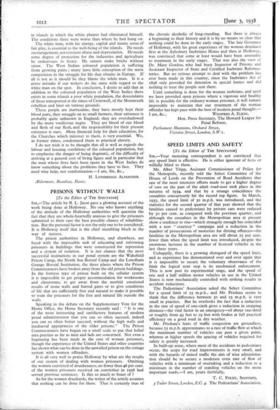SPEED LIMITS AND SAFETY [To the Editor of THE SPECTATOR]
Sm,—Your motoring correspondent is not convinced that any speed limit is effective. He is either ignorant of facts or wilfully blind to them.
Mr. Alker Tripp, Assistant Commissioner of Police for the Metropolis, recently told the Select Committee of the House of Lords on the Prevention of Road Accidents that one of the most intensive efforts made to get a higher degree of care on the part of the adult road-user took place in the autumn of 1934, and that by a strange coincidence the casualties concurrently hit the record top figure. In March, 1935, the speed limit of 3o m.p.h. was introduced, and the statistics for the second quarter of that year showed that the fatalities caused to pedestrians by private cars were reduced by 5o per cent. as compared with the previous quarter, and although the casualties in the Metropolitan area at present show a tendency to rise—which strangely enough has coincided with a new " courtesy " campaign and a reduction in the number of prosecutions of motorists for driving offences—the fatalities in the Metropolitan area are still about 25 per cent. fewer than when the speed limit was introduced, despite the enormous increase in the number of licensed vehicles in the last three years.
Unhappily, there is a growing disregard of the speed limit, and as experience has demonstrated over and over again that it is impossible to secure the voluntary observance of the limit the logical next step is its mechanical enforcement. This. is now past its experimental stage, and the speed of one and a half million motor vehicles in use in the United States is now mechanically controlled with striking results in accident reductions.
The Pedestrians' Association asked the Select Committee for a speed limit of 25 m.p.h., and Mr. Prioleau seems to think that the difference between 3o and 25 m.p.h. is very small in practice. But he overlooks the fact that a reduction in the rate of speed of one-sixth gives a reduction in stopping distance—the vital factor in an emergency—of about one-third or roughly from 43 feet to 29 feet with brakes at full practical efficiency on a good road in dry weather.
Mr. Prioleau's fears of traffic congestion are groundless, because 25 m.p.h. approximates to a rate of traffic flow at which the maximum number of vehicles can pass a given point, whereas at higher speeds the spacing of vehicles required for safety is greatly increased.
In built-up areas, where most of the accidents to pedestrians occur, the scope for road improvements is very small, and with the hazards of mixed traffic the aim of wise administra- tion should be to secure a moderate even rate of flow of vehicles with a minimum of overtaking and a reduction to a minimum in the number of standing vehicles on the more important roads.—I am, yours faithfully,
T. C. FOLEY, Secretary, 3 Tudor Street, London, E.G. 4. The Pedestrians' Association.


















































 Previous page
Previous page